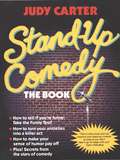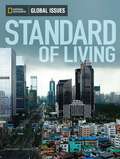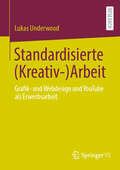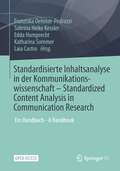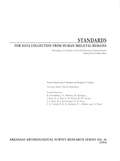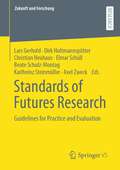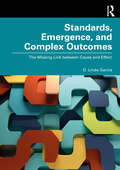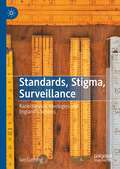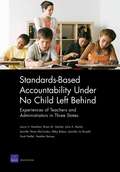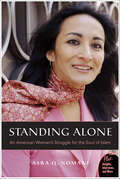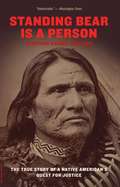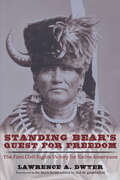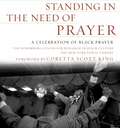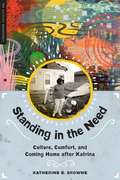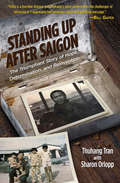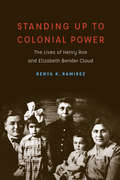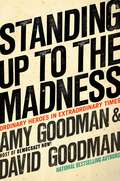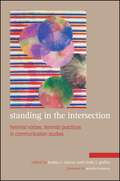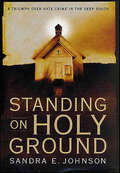- Table View
- List View
Stand-Up Comedy: The Book
by Judy CarterAll the world loves a clown and whether you want to clown around at parties or make a living as a standup comic, comedian Judy Carter can show you how to 'do' comedy.
Standard of Care and Hazmat Planning
by Robert A. BurkeWritten by a hazardous materials consultant with over 40 years of experience in emergency services, the five-volume Hazmatology: The Science of Hazardous Materials suggests a new approach dealing with the most common aspects of hazardous materials, containers, and the affected environment. It focuses on innovations in decontamination, monitoring instruments, and personal protective equipment in a scientific way, utilizing common sense, and takes a risk-benefit approach to hazardous material response. This set provides the reader with a hazardous materials "Tool Box" and a guide for learning which tools to use under what circumstances.Emergency responders are bound to a Standard of Care for response to hazardous materials incidents, based on federal law, regulations, and consensus standards. Volume Two, Standard of Care and Hazmat Planning, presents the hazardous materials legal issues and background on the Hazmat Standard of Care, including incidents where Care was violated and the repercussions felt. FEATURES Uses a scientific approach utilizing analysis of previous incidents Suggests guidance in developing plans for hazmat response Provides an exploration of laws, regulations, and standards Outlines the elements of Standard of Care response Includes case studies and in-depth history of Standard of Care response
Standard of Living: Essays on Economics, History, and Religion in Honor of John E. Murray (Studies in Economic History)
by Joshua Hall Patrick Gray Ruth Wallis Herndon Javier SilvestreThis anthology honors the life and work of American economist John E. Murray, whose work on the evolution of the standard of living spanned multiple disciplines. Publishing extensively in the areas of the history of healthcare and health insurance, labor markets, religion, and family-related issues from education to orphanages, fertility, and marriage, Murray was much more than an economic historian and his influence can be felt across the wider scholarly community. Written by Murray’s academic collaborators, mentors, and mentees, this collection of essays covers topics such as the effect of the 1918 influenza pandemic on U.S. life insurance holdings, the relationship between rapid economic growth and type 2 diabetes, and the economics of the early church. This volume will be of use to scholars and students interested in economic history, cliometrics, labor economics, and American and European history, as well as the history of religion.
Standardisierte (Kreativ-)Arbeit: Grafik- und Webdesign und YouTube als Erwerbsarbeit
by Lukas UnderwoodFolgt man den Diagnosen verschiedener Soziolog:innen, dann ist kreativ zu sein keine Anforderung mehr an nur einige wenige Arbeitnehmer:innen, sondern bildet das zentrale Dispositiv der modernen kapitalistischen Gesellschaft. Kreativ zu arbeiten setzt den gängigen Annahmen nach voraus, erstens kontinuierlich Neues hervorzubringen und zweitens einer nicht standardisierten Tätigkeit nachzugehen und nicht standardisierte Produkte hervorzubringen. Prädestiniert für solche Tätigkeiten scheinen Solo-Selbstständige aus der Kultur- und Kreativwirtschaft zu sein. Die vorliegende Arbeit geht der Frage nach, welche Rolle Kreativität für die Arbeit von ebendiesen spielt. Hierzu wird das Verhältnis von Kreativität und Standardisierung einer genaueren Betrachtung unterzogen, wobei der Fokus auf der Ebene des Arbeitsprozesses, des Produkts sowie der Handlung liegt. Empirische Grundlage bilden 18 qualitative Interviews mit Solo-Selbstständigen aus den Bereichen Grafik- und Webdesign sowie YouTube. Die Analyse rückt die Perspektive der Befragten in den Mittelpunkt und arbeitet zunächst die jeweiligen Besonderheiten der Arbeit in den beiden genannten Bereichen heraus. Die Ergebnisse der empirischen Analyse werden zur Reflexion über die drei genannten Ebenen genutzt und das Verhältnis von Standardisierung und Kreativität als dialektisch bestimmt. Diese Dialektik zeigt sich gegenstandsbezogen und ist zutiefst verwurzelt in den spezifischen Bedingungen, unter denen die Arbeit ausgeführt wird.
Standardisierte Inhaltsanalyse in der Kommunikationswissenschaft – Standardized Content Analysis in Communication Research: Ein Handbuch - A Handbook
by Katharina Sommer Edda Humprecht Franziska Oehmer-Pedrazzi Sabrina Heike Kessler Laia CastroIm vorliegenden Open-Access Handbuch wird der Status Quo standardisierter, inhaltsanalytischer Forschung in der Kommunikationswissenschaft identifiziert, systematisiert und für Forschende und Studierende zugänglich gemacht. Es behandelt Themen- und Forschungsbereiche des Nachrichtenjournalismus, der fiktionalen Inhalte sowie der Kommunikation von professionellen und LaienkommunikatorInnen. Der Fokus liegt auf den zentralen Fragestellungen und Forschungsdesigns unter besonderer Berücksichtigung der verwendeten Konstrukte/Variablen. In der dazugehörigen Datenbank „Database of Variables for Content Analysis – DOCA“ werden Variablenbeschreibungen zusammengetragen und recherchierbar gemacht. Das Handbuch bietet hierfür den kontextuellen Rahmen. Zusammen bilden sie die Grundlage zur Vereinheitlichung und damit Vergleichbarkeit inhaltsanalytischer Studien.
Standards For Data Collection From Human Skeletal Remains: Proceedings Of A Seminar At The Field Museum Of Natural History (Arkansas Archeological Survey Research Ser. #44)
by Douglas H. Ubelaker Jane E. Buikstra David AftandilianStandards for Data Collection has indeed become a standard for use as a manual in physical anthropology, bioarcheology, and human osteology research laboratories and college courses across North America. Originally created in anticipation of the need to document skeletal collections prior to NAGPRA repatriation, the volume is now a popular favorite among practitioners and students. Now in its 10th printing with a new, more durable plastic coil spiral binding.
Standards of Futures Research: Guidelines for Practice and Evaluation (Zukunft und Forschung)
by Axel Zweck Karlheinz Steinmüller Lars Gerhold Dirk Holtmannspötter Christian Neuhaus Elmar Schüll Beate Schulz-MontagForesight, futures studies, but also technology assessment and trend research are characterized by a research perspective directed towards the future. These results in fundamental peculiarities have to be taken into account in the conception of studies and in practical research work. The contributions to this anthology offer guidance for scientists and practitioners and describe the criteria and standards by which the quality of results and processes in futures studies can be assessed.
Standards, Emergence, and Complex Outcomes: The Missing Link between Cause and Effect
by D. Linda GarciaStandards, Emergence, and Complex Outcomes redefines how we think about standards, framing them as interfaces that govern interactions and connect causes to their effects. Expanding beyond traditional technical and geopolitical discussions, Garcia introduces a fresh theoretical perspective that positions standards as central to understanding complexity. From food safety and workplace regulations to standardized parts in manufacturing and our reliance on technology, standards shape nearly every aspect of modern life.By proposing a multidimensional approach, Garcia argues that standards are the mechanisms driving change, complexity is the backdrop for this change, emergence is the process by which change unfolds, and evolution is its ultimate outcome. Each chapter explores key elements of complexity theory and supports them with compelling historical and empirical examples, providing a richly detailed narrative that deepens understanding.This book is an essential resource for academics and students across the social sciences, policymakers shaping standards-dependent fields, and professionals in industries where standards dictate progress. Whether you're exploring the intersections of technology, governance, and complexity or looking to better navigate the systems shaping our world, this book offers vital insights into the pivotal role of standards in our increasingly interconnected society.
Standards, Stigma, Surveillance: Raciolinguistic Ideologies and England’s Schools
by Ian CushingThis book traces raciolinguistic ideologies in England’s schools, focusing on post- 2010 policy reforms which frame the language practices of low-income, racialised speakers as limited and deficient. Across interviews, policy mechanisms and classroom observations, the author shows how raciolinguistic ideologies are rooted in British colonial logics which continue to shape contemporary education policy. He shows how these policies require marginalised speakers to modify their speech patterns in line with normative standards of whiteness under new guises of social justice and research robustness. Finally, new visions for language education and linguistic justice are offered, demonstrating how teachers can see themselves as language activists to identify, resist and reject faults in a hostile and oppressive policy architecture. This book draws on fields including critical language policy, educational sociolinguistics, genealogy, raciolinguistics and critical language awareness.
Standards-Based Accountability Under No Child Left Behind
by Brian M. Stecher Laura S. Hamilton Jennifer Sloan Mccombs Julie A. Marsh Abby RobynSince 2001-2002, standards-based accountability provisions of the No Child Left Behind Act of 2001 have shaped the work of public school teachers and administrators in the United States. This book sheds light on how accountability policies have been translated into actions at the district, school, and classroom levels in three states.
Standing Alone: An American Woman's Struggle for the Soul of Islam
by Asra NomaniAs President Bush is preparing to invade Iraq, Wall Street Journal correspondent Asra Nomani embarks on a dangerous journey from Middle America to the Middle East to join more than two million fellow Muslims on the hajj, the pilgrimage to Mecca required of all Muslims once in their lifetime. Mecca is Islam's most sacred city and strictly off limits to non-Muslims. On a journey perilous enough for any American reporter, Nomani is determined to take along her infant son, Shibli -- living proof that she, an unmarried Muslim woman, is guilty of zina, or "illegal sex." If she is found out, the puritanical Islamic law of the Wahabbis in Saudi Arabia may mete out terrifying punishment. But Nomani discovers she is not alone. She is following in the four-thousand-year-old footsteps of another single mother, Hajar (known in the West as Hagar), the original pilgrim to Mecca and mother of the Islamic nation.Each day of her hajj evokes for Nomani the history of a different Muslim matriarch: Eve, from whom she learns about sin and redemption; Hajar, the single mother abandoned in the desert who teaches her about courage; Khadijah, the first benefactor of Islam and trailblazer for a Muslim woman's right to self-determination; and Aisha, the favorite wife of the Prophet Muhammad and Islam's first female theologian. Inspired by these heroic Muslim women, Nomani returns to America to confront the sexism and intolerance in her local mosque and to fight for the rights of modern Muslim women who are tired of standing alone against the repressive rules and regulations imposed by reactionary fundamentalists.Nomani shows how many of the freedoms enjoyed centuries ago have been erased by the conservative brand of Islam practiced today, giving the West a false image of Muslim women as veiled and isolated from the world. Standing Alone in Mecca is a personal narrative, relating the modern-day lives of the author and other Muslim women to the lives of those who came before, bringing the changing face of women in Islam into focus through the unique lens of the hajj. Interweaving reportage, political analysis, cultural history, and spiritual travelogue, this is a modern woman's jihad, offering for Westerners a never-before-seen look inside the heart of Islam and the emerging role of Muslim women.
Standing Bear is a Person: The True Story of a Native American's Quest for Justice
by Stephen Dando-CollinsThe only book about the landmark trial of the first Native American to be recognized legally as a person-an eloquent reminder of a fight well fought. -"Kirkus"
Standing Bear's Quest for Freedom: The First Civil Rights Victory for Native Americans
by Lawrence A. DwyerChief Standing Bear of the Ponca Nation faced arrest for leaving the U.S. government&’s reservation, without its permission, for the love of his son and his people. Standing Bear fought for his freedom not through armed resistance but with bold action, strong testimony, and heartfelt eloquence. He knew he and his people had suffered a great injustice. Standing Bear wanted the right to live and die with his family on the beloved land of his Ponca ancestors, located within the Great Plains of Nebraska. In telling his story, Standing Bear&’s Quest for Freedom relates an unprecedented civil rights victory for Native Americans: for the first time, in 1879, a federal court declared a Native American to be a &“person&”—a human being with the right to file an action for a redress of grievances in a federal court, like every other person in the United States. Standing Bear&’s victory in Standing Bear v. Crook began a national movement of reforming Native American rights—albeit a slow one. Because of the courage and leadership of Chief Standing Bear, the pervasive spirit of indifference of most Americans toward Native Americans was disrupted by this historic decision. America would never be the same.
Standing In The Need: Culture, Comfort, And Coming Home After Katrina
by Katherine E. BrowneStanding in the Need presents an intimate account of an African American family's ordeal after Hurricane Katrina. Before the storm struck, this family of one hundred fifty members lived in the bayou communities of St. Bernard Parish just outside New Orleans. Rooted there like the wild red iris of the coastal wetlands, the family had gathered for generations to cook and share homemade seafood meals, savor conversation, and refresh their interconnected lives. In this lively narrative, Katherine Browne weaves together voices and experiences from eight years of post-Katrina research. Her story documents the heartbreaking struggles to remake life after everyone in the family faced ruin. Cast against a recovery landscape managed by outsiders, the efforts of family members to help themselves could get no traction; outsiders undermined any sense of their control over the process. In the end, the insights of the story offer hope. Written for a broad audience and supported by an array of photographs and graphics, Standing in the Need offers readers an inside view of life at its most vulnerable.
Standing Our Ground: The Triumph of Faith Over Gun Violence: A Mother's Story
by Rosemarie Robotham Lucia Kay McBathFrom the national spokesperson for Everytown for Gun Safety and leading gun violence prevention advocate comes the riveting memoir of a mother’s loss and call to action, as well as a faith-based exploration of how the nation’s gun laws put a deadly target on American lives.Lucia Kay McBath knew deep down that a bullet could one day take her son. After all, she had watched the news of countless unarmed black men unjustly gunned down. Standing Our Ground: Putting Faith in God Over Faith in Guns is McBath’s memoir of raising, loving, and losing her son to gun violence, and the story of how she transformed her pain into activism. After seventeen-year-old Jordan Davis was shot by a man who thought the music playing on his car stereo was too loud, the nation grieved yet again for the unnecessary loss of life. Here, McBath goes beyond the timeline and the assailant’s defense—Stand Your Ground—to present an emotional account of her fervent fight for justice, and her awakening to a cause that will drive the rest of her days. But more than McBath’s story or that of her son, Standing Our Ground keenly observes the social and political evolution of America’s gun culture. A must-read for anyone concerned with gun safety in America, it harkens back to such bestsellers as The Short and Tragic Life of Robert Peace and Nobody.
Standing Out, Standing Together: The Social and Political Impact of Gay-Straight Alliances
by Melinda MiceliJust a decade ago, requests by students to establish groups to support gay and lesbian students were rare and generally met with shock and confusion by school administrators and local communities. Today there are more than 1600 gay straight alliances (GSAs) across the country. Standing Out, Standing Together documents the emergence of gay straight alliances in public schools across America - from factors that have contributed to the relatively rapid spread of GSA to those that stirred controversy and posed roadblocks. Using over 10 years of interviews with students, teachers, administrators and political activists; case studies; and local and national media reports, Miceli explores the personal and political stakes involved in the battles over GSAs. Although the book acknowledges and documents the harassment, abuse and problems suffered by many gay, lesbian, transgendered, and bisexual students, its primary focus is on these students as political activists, rather than as passive victims, making it a unique contribution to sociologists, educators, political activists and LGBTreaders alike.
Standing Up After Saigon: The Triumphant Story of Hope, Determination, and Reinvention
by Thuhang Tran Sharon OrloppThis inspiring true story of familial love and triumph through adversity follows a father and daughter separated by war in Vietnam. In 1970, near the end of the Vietnam War, Thuhang Tran was born in Saigon. She contracted polio as a baby, and though her family sacrificed much to seek treatment, their efforts were halted by Saigon&’s fall. Her father, Chinh Tran, an air traffic controller in the South Vietnam Air Force, was lost during the evacuations and presumed dead. This powerful memoir follows both father and daughter through their respective struggles, from Thuhang's battle with polio and the impact of her father's absence, to Chinh's immigration to the United States and his desperate 15-year mission to be reunited with his family. Through all the seemingly impossible hurdles she&’s faced, Thuhang has remained hopeful and resilient. Now she tells her incredible story, inspiring those around her to find strength through perseverance.
Standing Up to Colonial Power: The Lives of Henry Roe and Elizabeth Bender Cloud (New Visions in Native American and Indigenous Studies)
by Renya K. RamirezStanding Up to Colonial Power focuses on the lives, activism, and intellectual contributions of Henry Cloud (1884–1950), a Ho-Chunk, and Elizabeth Bender Cloud (1887–1965), an Ojibwe, both of whom grew up amid settler colonialism that attempted to break their connection to Native land, treaty rights, and tribal identities. Mastering ways of behaving and speaking in different social settings and to divergent audiences, including other Natives, white missionaries, and Bureau of Indian Affairs officials, Elizabeth and Henry relied on flexible and fluid notions of gender, identity, culture, community, and belonging as they traveled Indian Country and within white environments to fight for Native rights. Elizabeth fought against termination as part of her role in the National Congress of American Indians and General Federation of Women’s Clubs, while Henry was one of the most important Native policy makers of the early twentieth century. He documented the horrible abuse within the federal boarding schools and co-wrote the Meriam Report of 1928, which laid the foundation for the Indian Reorganization Act of 1934. Together they ran an early college preparatory Christian high school, the American Indian Institute. Standing Up to Colonial Power shows how the Clouds combined Native warrior and modern identities as a creative strategy to challenge settler colonialism, to become full members of the U.S. nation-state, and to fight for tribal sovereignty. Renya K. Ramirez uses her dual position as a scholar and as the granddaughter of Elizabeth and Henry Cloud to weave together this ethnography and family-tribal history.
Standing Up to the Madness: Ordinary Heroes in Extraordinary Times
by Amy GoodmanStanding Up to the Madness not only is a timely, inspiring, and even revolutionary look at who wields the greatest power in America--everyday people who take a chance and stand up for what they believe in--but also offers advice on what you can do to help. Where are the millions marching in the streets to defend human rights, civil liberties, and racial justice? Where is the mass revulsion against the killing and torture being carried out in our name? Where are the environmentalists? Where is the peace movement? The answer: They are everywhere. The award-winning sister-brother team of Amy Goodman, host of Democracy Now!, and investigative journalist David Goodman traveled the country to detail the ways in which grassroots activists have taken politics out of the hands of politicians. Standing Up to the Madness tells the stories of everyday citizens who have challenged the government and prevailed. As the Bush administration has waged war abroad and at home, it has catalyzed a vast groundswell of political action. From African-American residents of deluged New Orleans who are fighting racism and City Hall to regain their homes; to four Connecticut librarians who refused to spy on their patrons, challenged the USA PATRIOT Act, and won; to a group of high school students who were barred from performing a play they wrote on the Iraq War based on letters from soldiers; to the first U.S. Army officer to publicly refuse orders to deploy to Iraq, charging that his duty as an officer is to refuse to fight in an illegal and immoral war, Standing Up to the Madness profiles citizens rising to extraordinary challenges. And, in the process, they are changing the way that politics is done, both now and in the future. In communities around the United States, courageous individuals have taken leaps of faith to stop the madness. They could only hope that if they led, others would follow. That is how movements are born. What begins as one, eventually becomes many. In that tradition, the authors have included the ways in which any individual can take action and effect change.
Standing in the Intersection: Feminist Voices, Feminist Practices in Communication Studies
by Cindy L. Griffin Karma R. ChávezWinnerof the 2013 Best Edited Book Award presented by the Organization for the Study of Communication, Language, and Gender (OSCLG)Building on the decades of work by women of color and allied feminists, Standing in the Intersection is the first book in more than a decade to bring communication studies and feminist intersectional theories in conversation with one another. The authors in this collection take up important conversations relating to notions of style, space, and audience, and engage with the rhetoric of significant figures, including Carol Moseley Braun, Barbara Jordan, Emma Goldman, and Audre Lorde, as well as crucial contemporary issues such as campus activism and political asylum. In doing so, they ask us to complicate notions of space, location, and movement; to be aware of and explicit with regard to our theorizing of intersecting and contradictory identities; and to think about the impact of multiple dimensions of power in understanding audiences and audiencing.
Standing in the Need: Culture, Comfort, and Coming Home After Katrina (The Katrina Williams Novels)
by Katherine E. Browne&“The vivid story of one family&’s ordeal in Hurricane Katrina . . . offers completely new and highly relevant insights into disaster response.&” —Susanna Hoffman, disaster anthropologist and director, Hoffman Consulting Standing in the Need presents an intimate account of an African American family&’s experience after Hurricane Katrina. Before the storm struck, this family of one hundred fifty members lived in the bayou communities of St. Bernard Parish just outside New Orleans. Rooted there like the wild red iris of the coastal wetlands, the family had gathered for generations to cook and share homemade seafood meals, savor conversation, and refresh their interconnected lives. In this lively narrative, Katherine Browne weaves together voices and experiences from eight years of post-Katrina research. Her story documents the heartbreaking struggles to remake life after everyone in the family faced ruin. Cast against a recovery landscape managed by outsiders, the efforts of family members to help themselves could get no traction; outsiders undermined any sense of their control over the process. In the end, the insights of the story offer hope. Written for a broad audience and supported by an array of photographs and graphics, Standing in the Need offers readers an inside view of life at its most vulnerable. &“Standing in the Need delivers an epic story about disaster and the haunting problems imposed by our &‘recovery culture.&’ The lesson in these pages is of urgent concern as the world moves into weather we have never seen before.&” —Mindy Fullilove, MD, Mailman School of Public Health, Columbia University &“Browne suggests that recovery agencies could reduce suffering and speed healing by learning about the history, culture, and distinctive customs and needs of disaster-impacted communities.&” —Contemporary Sociology
Standing in the Need: Culture, Comfort, and Coming Home After Katrina (The Katrina Williams Novels)
by Katherine E. Browne&“The vivid story of one family&’s ordeal in Hurricane Katrina . . . offers completely new and highly relevant insights into disaster response.&” —Susanna Hoffman, disaster anthropologist and director, Hoffman Consulting Standing in the Need presents an intimate account of an African American family&’s experience after Hurricane Katrina. Before the storm struck, this family of one hundred fifty members lived in the bayou communities of St. Bernard Parish just outside New Orleans. Rooted there like the wild red iris of the coastal wetlands, the family had gathered for generations to cook and share homemade seafood meals, savor conversation, and refresh their interconnected lives. In this lively narrative, Katherine Browne weaves together voices and experiences from eight years of post-Katrina research. Her story documents the heartbreaking struggles to remake life after everyone in the family faced ruin. Cast against a recovery landscape managed by outsiders, the efforts of family members to help themselves could get no traction; outsiders undermined any sense of their control over the process. In the end, the insights of the story offer hope. Written for a broad audience and supported by an array of photographs and graphics, Standing in the Need offers readers an inside view of life at its most vulnerable. &“Standing in the Need delivers an epic story about disaster and the haunting problems imposed by our &‘recovery culture.&’ The lesson in these pages is of urgent concern as the world moves into weather we have never seen before.&” —Mindy Fullilove, MD, Mailman School of Public Health, Columbia University &“Browne suggests that recovery agencies could reduce suffering and speed healing by learning about the history, culture, and distinctive customs and needs of disaster-impacted communities.&” —Contemporary Sociology
Standing on Holy Ground: A Triumph over Hate Crime in the Deep South
by Sandra E. JohnsonA sweeping epidemic of hate crime targeted over one hundred Southern Black Churches between 1995 and 1996, leaving them in charred ruins. St. John Baptist Church in Dixiana, South Carolina, was one of the first destroyed. This small, isolated church had faced dark times before. It had been viciously desecrated in 1985 and withstood more attacks until it was burned down in August 1995.From the beginning, two friends--a white woman named Ammie Murray, and a black woman named Barbara Simmons--rallied volunteers to rebuild the historic St. John. Much to their amazement, hundreds of people from diverse racial and cultural backgrounds responded to their call for help. They refused to stop rebuilding the church-despite repeated attempts on Ammie and Barbara's lives and relentless attacks on the church. Soon, these two heroic women joined the leaders and congregations from two other burned, black churches-Macedonia Baptist and Mt. Zion AME-in leading the nation in a courageous battle against hate crime in the deep South. Beautifully rendered with warmth and grace, this inspiring story of enduring friendship, reconciliation, spiritual strength, and hope shows us how we can triumph over racial hatred.
